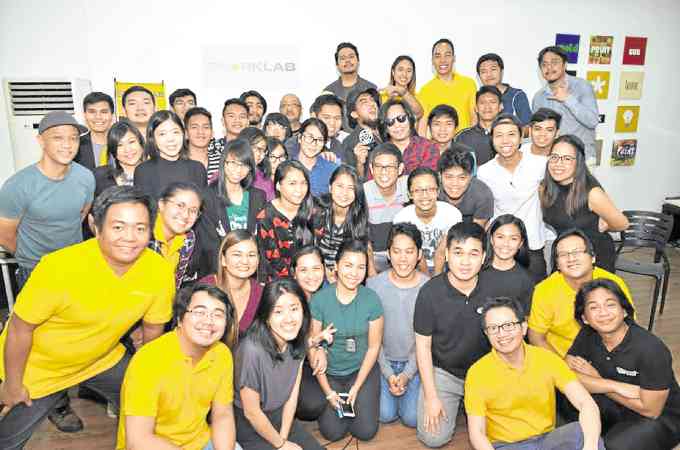
Sparklab team, technology leaders, startup entrepreneurs and students during the launch of the innovation center.
The Philippines may not be so advanced in terms of technological infrastructure, but it does house exceptional talents who can shake up the industry.
Sparklab Innovation Center, a newly opened comaking hub in Teacher’s Village, Quezon City, aspires to spark that desire to bring out and develop innovative ideas and creations among young Filipino innovators and inventors through its “innovation center.”
“There are a lot of technologies that have not been brought here in the Philippines or the market is not aware yet that these technologies exist.
And if they do know that these exist, they don’t know how to use them well. This facility that we have is meant to educate the market on what’s out there that can help them build their ideas,” cofounder Allan Hao Chin told the Inquirer during the launch of Sparklab.
Sparklab, a multimillion investment by a group of engineers from technology training and consulting center Thinklab and visual communication technology solutions company Norde International Distributors, offers not just a cozy makerspace that can host 150 makers but cutting-edge machines and equipment, too.
Unlike other spaces in the country, the two-story hub boasts of several industrial-level tools for product design and fabrication, such as three-dimensional (3D) printer and scanner, laser cutter and Computer Numerical Control (CNC) router.
These pieces of equipment can produce prototypes that can be used by anyone who wants to be a member of Sparklab.
Membership rates for individual makers and startups start at P895 daily and P9,990 monthly.
Basic packages offered include assistance and coaching by Sparklab’s in-house engineers, use of coworking space, hand tools, basic equipment and access to the internet. Advanced machines like the CNC router can be used on a pay-per-use basis.
“We would like to think of ourselves as an extension of our educational institutions. There are a lot of schools where [the students] have an idea but they cannot implement it because the school doesn’t have the proper equipment to execute those ideas,” he said.
The center is also set to host formulations of new technologies, particularly applications that will cater to the advancement of the local agriculture sector.
It will be done in partnership with the Department of Science and Technology (DOST), as the agency welcomes ideas and inventions from the public that would solve issues confronting different sectors.
“DOST welcomes the collaboration with Sparklab in creating new ideas and technologies that would be beneficial to the society,” said Philippine Council for Industry Energy and Emerging Technology Research and Development (PCIEERD) Executive Director Carlos Primo David, who delivered a talk before technology leaders, students and startup entrepreneurs during the launch.
With great potential seen in young Filipino makers, Sparklab, through its resident engineers, aims to further hone the talents of the youth through workshops and training sessions on technology.
“We have a lot of support from the government. We are aligned in our thrust. Our goal is really to be able to develop our startup-maker community. We want to create more applications that will help local industries,” Chin said.
For 18-year-old Angelo Casimiro, such a hub will definitely help makers like him produce prototypes of their projects.
Casimiro, an Electronics and Communications Engineering student, is known for having invented electricity-generating shoes when he was just 15.
He only had his bedroom as his laboratory when he built an estimated 300 tools such as a fully-functional replica of the Star Wars BB-8 robot and at least three original inventions—water-powered flashlight, health monitoring bracelet and electricity-generating shoes.
He has not yet applied for a patent for his footwear, but Casimiro disclosed that his invention could soon turn into a business.
“We’re looking at [mass producing my inventions]. [My family and I] plan to build a company since at home, I also have a laser cutter and [other equipment] for production. However, there are still a lot of fabrications needed for the footwear to be ready for mass production. But it’s feasible,” he said.
His health band also has great potential in the market.
The bracelet is aimed at patients with health conditions such as high blood pressure.
When a patient wears it, it can instantly detect his or her vital signs. And if anything goes wrong, or worse, if the patient suffers from a heart attack, the bracelet will immediately call the hospital to ask for urgent aid.
“I craft inventions for public service, curiosity and sometimes for the prize in competitions. I also make money online, particularly on Youtube where I upload do-it-yourself (DIY) tutorials for other makers,” he said.
He hopes that more makers like him—even those from the countryside—will have access to cutting-edge machines like those at Sparklab to help them turn their ideas into reality. —CONTRIBUTED